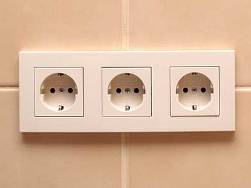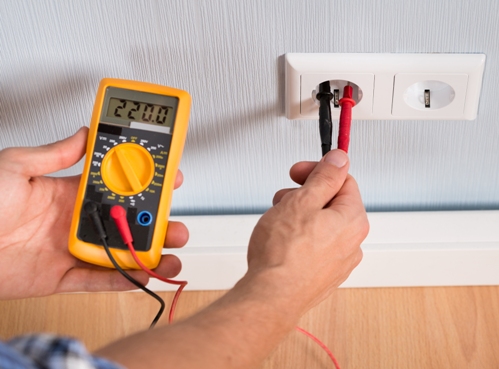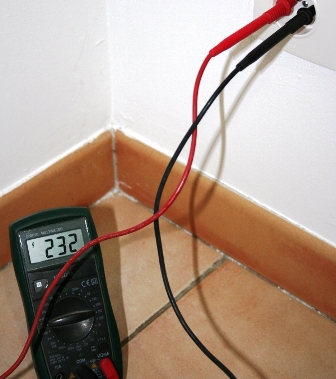Categories: Featured Articles » Electrician at home
Number of views: 120903
Comments on the article: 5
What voltage in the household network is optimal for the operation of electrical appliances
 Voltage level is one of the criteria for the quality of power supply. Each household appliance is designed for continuous normal operation provided that it is supplied with voltage that is within acceptable limits. In this article, we will consider the question of what voltage in the household network is optimal for the operation of electrical appliances.
Voltage level is one of the criteria for the quality of power supply. Each household appliance is designed for continuous normal operation provided that it is supplied with voltage that is within acceptable limits. In this article, we will consider the question of what voltage in the household network is optimal for the operation of electrical appliances.
Voltage level in the electric network
First of all, it should be noted that many different factors affect the voltage level in the electric network. Electricity from the source - power plants to the final consumer, in particular to residential buildings, comes through several stages of conversion. At the first stage, the voltage rises to transmit it over long distances, through the power system. As you approach the end user, electricity goes through several stages of voltage conversion to the values used in everyday life.
It is impossible to ensure a fixed voltage value in different parts of the power system, since various processes constantly occur in the power system: the load increases or decreases, the amount of generated electricity at power plants changes accordingly, emergency situations occur at different parts of the power network, which affect this or that to voltage levels. Therefore, at each stage of the conversion of electricity, the voltage level is adjusted, both in the direction of increasing and decreasing.
The main task of voltage regulation is to ensure the voltage level in certain sections of the electric network within acceptable values. The same applies to the final stage, which provides a voltage reduction of the value used in everyday life - 220/380 V.
In the 220 V single-phase electric network most often used for power supply to consumers, the normally permissible voltage deviations are within +/- 5%. That is, the voltage range of 209-231 V is normal, it can be constant, compliance with the mains voltage within these values is one of the criteria for high-quality power supply.
But, as mentioned above, emergency operation can occur in the electrical network, which can affect voltage levels in the electrical network. In this regard, there is another norm - the maximum permissible voltage deviations, which are +/- 10% or 198-242 V.
These voltage deviations are allowed for a short time, as a rule, during the liquidation of an emergency in the electric network or during operational switching, during which a temporary change in the voltage values of the electric network occurs.
What voltage in the household network is optimal for the operation of electrical appliances?
Above are the general norms of voltage of the electric network. As for household electrical appliances, in most cases they are designed for normal operation in the range of maximum permissible voltage deviations, that is, 198-242 V. In this case, electrical appliances should not fail in the event of a brief excess of voltage above 242 V.
If we consider the ranges of permissible voltages in the passports of household electrical appliances, then we can distinguish two groups of electrical appliances. The first group includes those electrical appliances that are least affected by voltage surges - an electric kettle, an electric furnace, a boiler, an electric heater and other electrical devices in which the main structural element is a thermal heating element.
The second group includes electrical appliances that are most susceptible to voltage surges - these are, first of all, computer equipment, power supplies of various equipment, audio and video equipment and various expensive electrical appliances that are structurally equipped with electronic circuits, converters.
In the passport of electrical appliances of the first group in most cases you can see the recommended operating voltage of 230 V. In fact, these electrical appliances will work at a lower voltage, but they will work less efficiently.
Electrical appliances of the second group, as more susceptible to voltage drops, are designed taking into account work in wide ranges. Often the ranges of operating voltages go below the maximum permissible. For instance, Power Supply audio-video equipment, mobile phone charger is designed to operate within 100-240 V.
Separately, household appliances that are structurally equipped with an electric motor, pump or compressor should be highlighted. The listed elements are designed to operate at rated voltage, as a rule, this is 220-230 V.

In the event of a decrease in voltage in the electric network, the load current in the electric motor (pump, compressor) increases, which in turn leads to overheating of its windings and a decrease in the life of the insulation. In this case, the lower the voltage in the electric network, the shorter the service life of these electrical appliances, in particular their structural elements - electric motors (pumps, compressors).
Given the ranges of permissible voltage of all electrical appliances used in everyday life, we can conclude that the most optimal voltage in the electric network is a voltage of 230 V. With this voltage value, electrical appliances with electric motors will work normally, heating elementsas well as electrical appliances structurally having electronic circuits and converters.
Considering the question of what voltage in the household network is optimal for the operation of electrical appliances, it should be borne in mind that not only the voltage level is important, but also its stability.
By stability is meant the absence of power surges, both upward and downward. Power surges adversely affect the operation of electrical appliances and, ultimately, can lead to their failure.
See also at e.imadeself.com
:

